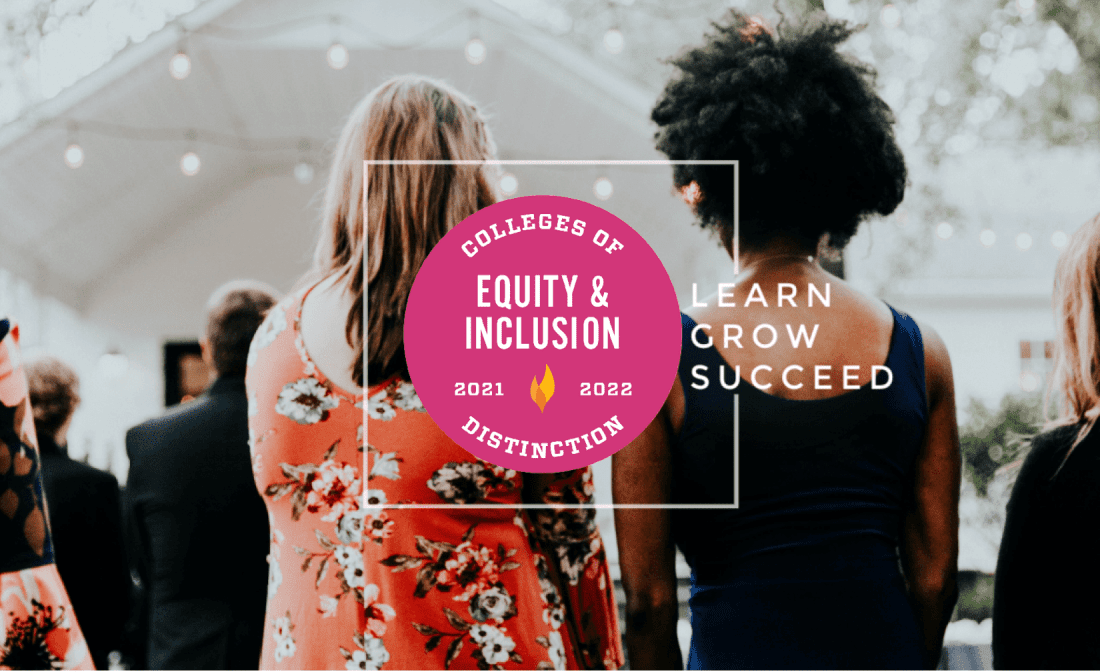Our Methodology for Equity & Inclusion Recognition
When vetting our schools for the Equity & Inclusion recognition, we take a multilayered approach that analyzes each school from the administrative level to the day-to-day student experience. We keep in mind the geographic location of the school as well as its surrounding neighborhood’s demographics in order to assess it fairly in relation to its peers.
We look for equity and justice in practice, not just in name: E&I-recognized schools bring inclusion into all aspects of the college experience beyond an office for diversity. Regardless of a school’s size, funding, and demographics, it is important to us to see whose intentional programming has a distinguishable impact. Beyond diversity, these schools pursue equity by catering to students of different racial, ethnic, socioeconomic backgrounds as well as their ability, sexual orientation, and gender identity.
It is a challenge to assess campus equity, one that is blatantly obvious when looking at the way in which the most widely read college rankings and lists choose their “most diverse colleges.” These websites tend to make their calculations based on a narrow set of statistics, primarily nothing more than student demographic breakdowns and the number of pell-eligible and low-income students on campus.
Identifying historically excluded and underserved students is a critical part of progress in higher education, but there also are a myriad other ways in which schools can be making inclusion both a programmatic and cultural priority. It is our aim at Colleges of Distinction to identify the schools that excel in campus-wide efforts to serve every student with a proactive regard for their needs at all intersections of their identity.
OUR METHODOLOGY
The Colleges of Distinction are all selected in our overall cohort through a review of how they embody the Four Distinctions in their academic communities. In line with the emphasis we place on the High-Impact Practices, we seek that all students are engaging equally in the hands-on experiences that are available to them. This assessment can be done through metrics in such resources as the National Survey of Student Engagement (NSSE), which measures the rates at which students engage with study abroad, service-learning, internships, etc. while enrolled. If the data is available, we check for even rates of engagement across all racial and ethnic identities to ensure that these supplemental experiences are accessible to all.
Student input, of course, is also critical to our assessment of a school’s true measure of inclusivity. We review Campus Climate Surveys in search of an upward trend of student satisfaction on campus. We look for disparities in students’ perception of their safety as well as their treatment in the classroom.
In most cases, the details of student equity and justice efforts are self-reported through such national resources as the Sustainability Tracking, Assessment & Rating System (STARS) by the Association for the Advancement of Sustainability in Higher Education (AASHE), the Campus Pride Index, and INSIGHT Into Diversity. We also study progress reports and assessments from the American Council on Education (ACE), the Education Trust, the National Association of Diversity Officers in Higher Education (NADOHE), and the National Center for Education Statistics (NCES). On top of our independent research, we invite schools to send us information and apply for recognition through a detailed survey. This helps us look for the exhaustiveness of available programming and support within the following key areas:
- Administrative Accountability – Equity & Inclusion must be a priority of an entire institution, not just its office of diversity. Statements of inclusion should be within the school’s institutional mission, and procedures for equitable education should be a cornerstone of its strategic plan. The administration makes clear its commitment to progress through annual progress reports, cultural competence training for students and faculty, and inclusion efforts and funding explicitly addressed in the overall budget.
- Diverse Population of Students and Faculty – A school should make an active effort to enroll a diverse student body, extending its recruitment to various communities and publicizing the resources it has to address possible financial concerns. The college should also work to employ a diverse faculty, as students from minority populations are more likely to succeed when they have professors who represent them. No matter the population breakdown, the school should also educate its faculty and staff so that they can treat students fairly and with a conscious acknowledgment of their needs.
- Food and Housing Security – A school should be acutely aware that not all students can afford room and board—neither on nor off campus. With 39% of students facing food insecurity, and 46% facing housing insecurity, schools nationwide should help meet basic needs through such services as a campus food pantry, resident life scholarships, and/or neighborhood partnerships to help find affordable housing.
- Physical and Mental Health Care – Just as housing and food are not equally accessible, neither are dependable resources for health care. And especially since students of color and other marginalized populations face unique stressors that may impact their mental health, a school should provide free or reduced-price care to any student who needs it.
- Pell Grants and Financial Aid – Scholarships and comprehensive financial guidance are necessary for most low-income and first-generation students. Schools can lessen the burden by providing financial aid resources that are transparent and easy to navigate, and staff can point students toward all that is available to them.
- Academic Inclusion – Area, ethnic, and cultural studies enrich an education, helping all students be more culturally competent for a global society. Whether diversity is integrated into the core curriculum or otherwise stressed in the classroom, all students should engage with high-impact practices that further expose them to the myriad perspectives, lifestyles, and needs of other populations.
- Campus Activities and Community Support – Inclusion is just as important as diversity, and an institution should provide the means for every student to feel welcome on campus. The school itself may host various programs to promote a tolerant environment, including educational workshops, a multicultural engagement center, and clubs or organizations that cater to different ethnic, cultural, and gender identities.
Our team created a scorecard based on the student engagement/satisfaction surveys as well as the availability and effectiveness of the programs and policies included in the above categories. It was important for us not just to see whether a school had certain programming in place, but also that such efforts had been in place and utilized for multiple years. We found z-scores for each school’s calculation to help us understand how they compare to other schools of their size and within their region. We used the hard numbers as a guide on top of our individualized review for difficult-to-quantify aspects of community impact.
WHAT ISN’T INCLUDED
Schools that do not appear on our list of Equity & Inclusion Colleges of Distinction are not necessarily non-inclusive; rather, they simply have not met our rigorous criteria designed for the schools going above and beyond in all aspects of inclusion for all underserved populations. Common shortcomings include a lack of recruitment and retention strategies for underrepresented students and faculty, localized multicultural programming that does not penetrate the rest of the campus, and nondiscrimination policies that do not fully protect all identities and expression. Furthermore, we also look for cracks in the system that might suggest that existing programs have good intentions with minimal or negative impact.
We also find it our responsibility to ensure that efforts of equity and justice on campus have been embedded in the campus culture for multiple years. We applaud the institutions who have made recent changes to their diversity, equity, and inclusion plans in light of recent national discussions, but we choose to await the outcomes of these changes while they are still new on campus. Nevertheless, we are always encouraged by schools that understand that achieving equity is an ongoing process with no finish line; there is always room for improvement. Schools that take the time to learn, repair, and progress will always stand out to us.
ADDITIONAL NOMINATIONS
We recognize that statistical models for things as complex as higher education can leave out institutions that deserve to be celebrated, regardless of how thoroughly we conduct our search. Especially in areas of equity and belonging, much of the available data is volunteered, self-reported information that is often underreported and difficult to find. That’s why we invite nominations from administrators, faculty, and counselors to review schools to add to our cohort.
Schools that fall outside of our assigned parameters can choose to go through a selection process that includes a team review, survey request and, when appropriate, an interview with the administration. We will look over the information provided along with a deeper review of the campus climate to better inform our decision.



